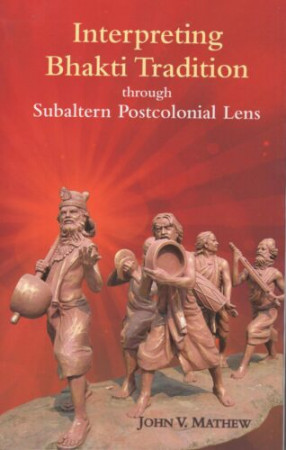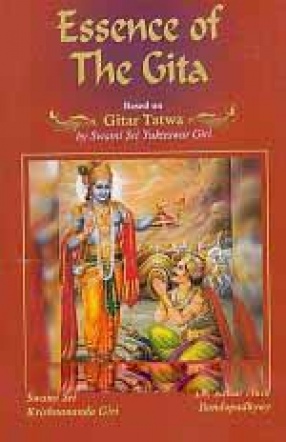Interpreting Bhakti Tradition Through Subaltern Postcolonial Lens
The book investigates the bhakti beliefs and practices of the subaltern Kabirpanth community in comparison with the nirguna bhakti thought of their guru, the medieval iconoclastic bhakti saint Kabir. By doing so, the book attempts to investigate the Kabirpanthis’ attempt at dissent and submissiveness vis-a-vis the dominant Sanskritic Hindu tradition. This dual strategy of dissent and submissiveness is analysed through subaltern postcolonial lens as well as by employing social anthropological empirical research. The book begins by making an analytical study of the medieval Bhakti movement and the nirguṇa bhakti teachings and practices of Kabir. Using postcolonial discursive tools such as postcolonial mimicry, ambivalence and hybridity, the author investigates how the bhakti beliefs and practices of the subaltern Kabirpanth community are elements of subversive and resistance stance against the dominant Sanskritic Hindu tradition. This book is a must read for anyone interested in bhakti religion and movement and those who wish to analyse subaltern religion through postcolonial lens. CONTENTS Preface Acknowledgements Abbreviations List of Tables Introduction The Research Problem Background of the Study Significance of the Study Definition of Key Terms Medieval Hindu Bhakti Subaltern Response Previous Studies in Related Area of Research Methodology Employed in the Study Outline of the Book 1. Medieval Hindu Bhakti in North India Introduction A Study of the Concept of Bhakti Major Forms of Bhakti Origin and Growth of Bhakti Bhakti Literature Socio-Religious, Politico-Economic Context of the Medieval Bhakti Movement Socio-Religious Context of the Medieval Bhakti Movement Political and Economic Context of the Medieval Bhakti Movement Division of Bhakti in North India Conclusion 2. Methodological Considerations Introduction Meaning of the Term Subaltern Subaltern Consciousness Subaltern Religion Postcolonial Theory Postcolonialism: Its Definition and Usage Colonialism Postcolonialism: Its Definition Various Usages of the Term Postcolonialism The Origin of Postcolonialism as a Field of Study Post in Postcolonial Theory Theoretical Roots/Assumptions of Postcolonial Theory Features of Postcolonial Studies A Critical Stance or Subversive Reading Strategy A Resistance Discourse Representation Attaining New Hybridized Identity Contrapuntal Reading Key Issues in Postcolonial Studies Subaltern Studies Group and Subaltern Postcolonial Theory Subaltern Response in Terms of Postcolonial Theoretical Concepts Postcolonial Mimicry Postcolonial Ambivalence Postcolonial Hybridity Postcolonial Appropriation Postcolonial Binarism Postcolonial Catachresis Conclusion 3. Life and Teachings of Kabīr with Special Reference to Bhakti Introduction A Brief Overview of Kabīr’s Life The Sources for Kabīr’s Teachings Kabīr-granthāvalī Ādi-Granth The Bījaka The Teachings of Kabīr: A Comprehensive Analysis Kabīr’s Doctrine of God God as Nirguṇa God as Saguṇa God as Creator and Sustainer of the World God as Sovereign, Eternal and Immanent Kabīr’s Concept of the World Kabīr’s Concept of Maya Kabīr’s Teachings on Human Person (Jīva) Mana The Fate of the Unliberated Human Being The Nirguṇa Bhakti of Kabīr The Bhakti Teachings of Kabīr Śabda: The Word Nāma: The Name of God Guru: The Divine Preceptor Nāma-Sumirana Dayā: Grace of God God’s Grace as an Important Factor in Kabīr’s Nirguṇa Bhakti The Ultimate Experience (Mokṣa) Nirguṇa Bhakti Practice of Kabīr Rejection of Outward Religion Rejection of Caste Rejection of the Traditional Acts of Merits Rejection of Avatāras Rejection of Idolatry Rejection of Tīrtha Rejection of Ascetic Practices Rejection of Scriptural and Religious Authority Conclusion 4. The Kabīrpanth Movement: A Brief Introduction Introduction Meaning of the Term Panth and Kabīrpanth The Founder of Kabīrpanth Date and Context of the Founding of Kabīrpanth Kabīrpanth as a Subject of Study Social Composition of the Kabīrpanthīs The Kabīrpanth: Its Main Branches Benares Kabīr Caurā Branch Lahartārā Magahar Chhattisgarh Branch Bhagatāhi Branch Jagudās Branch Phatuhā Branch Kabīr Caurā Jagdishpurī (Purī) Kabīr Nirṇaya Mandir, Burhanpur General Remarks Conclusion 5. Understanding of Bhakti in the Benares Kabīr Caurā Branch Introduction An Overview of Important Beliefs and Teachings Understanding of God as Paramātmā Rāma-Nāma as Paramātmā Kabīr as Paramātmā and Sadguru Relation between Paramātmā and the World Relation between Paramātmā and Human Person Bhakti Teachings and Practices of the Kabīr Caurā Branch of the Kabīrpanth Community Understanding of Bhakti Importance of Bhajana in Bhakti Four Types of Bhajana Satsaṅga in Kabīrpanth Emphasis on Kīrtana Sumirana The Mantra of Rāma Nāma or Nāma-Sumirana Kabīrpanthī Understanding of Means of Mokṣa State of Mokṣa Guru in Kabīrpanth Pilgrimage to the Santas Bhakti Understanding of Caste Bhakti Understanding of Karma and Punarjanma Teachings Against Traditional Acts of Merit A Ridicule of the Hindu Trimūrti and Avatāras Against Saguṇa Worship and Idol Worship Injunction Against Non-Vegetarianism Teachings on Yoga Wearing of Kaṇṭhī and Tīlaka Rites and Rituals of the Kabīrpanth Community Religious Duties at the Kabīr Caurā Maṭha Caukā Āratī Initiation Ceremony Bījaka Pāṭha in Kabīrpanth Festivals Conclusion 6. A Subaltern Postcolonial Analysis of Bhakti of the Kabīrpanth Community Introduction Theoretical Discussions in Relation to the Cultural Traditions of Low-caste Groups Subaltern Postcolonial Response Mimicry as an Assimilation and Resistance Stance Dual Function of Mimicry on the Kabīrpanthīs The Impact on the Kabīrpanthīs Due to Mimicry Mimicry as a Sign of Affiliation and Antagonism towards the Dominant Sanskritic Hindu Tradition Subaltern Postcolonial Consciousness as a Strategic Stance Resistance and Oppositional Stance vis-à-vis the Dominant Sanskritic Hindu Tradition’s Beliefs and Practices Resistance and Oppositional Stance through Kabīrpanthī Bhakti Beliefs and Practices Kabīrpanthī Symbols as Iconic Symbolic Means of Resistance Rejection of Hierarchical Social Ideology of Varṇāśrama-dharma as a Radical Stance Kabīrpanth Community as a Hybridized Community Appropriation Alternate Soteriological Resource Development of Postcolonial Consciousness Among the Kabīrpanthīs through Their Sociocultural Forms Two Indian Approaches towards Subaltern Liberation: Gandhi and Ambedkar Relevance of Kabīrpanthī Subaltern Experience for Subaltern Christian Theology A Subversive Reading Strategy A Synthetic Subaltern Hermeneutics Reading for a Liberative/Creative Reappropriation Subaltern Hermeneutics for Community Emancipation A Subaltern Hybridized Identity Formation Subaltern Theology as a Theology of Constructing Critical Consciousness Among the Subalterns A Subaltern Community Reading of the Biblical Texts in Terms of Subaltern Satsaṅga A Subaltern Christology from the Bhakti Teachings of the Kabīrpanthīs Jesus as Guru and God Incarnate Bhaṇḍārā Fellowship of Jesus Christ Conclusion Conclusion Visuals Bibliography Word Index Name Index
Get it now and save 10%
BECOME A MEMBER







Bibliographic information